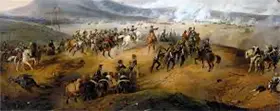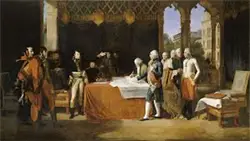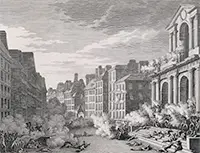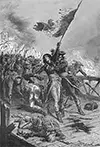Napoleon Bonaparte: Giant of the Age
Part 2: A New Government and War Bonaparte did not regain his command and turned down an offer to command the artillery in the force fighting the uprising in the Vendée. He was still in Paris the following October when the National Convention created a new Constitution and needed armed intervention to protect it. In October 1795, just days after the new Constitution was declared in force, a large number of royalists took up arms against the republican government and aimed to set up their own, dedicated to the return of a constitutional monarchy. The plan was to march down both banks of the Seine and converge on the 
The new Constitution took hold, and Bonaparte became head of the Army of the Interior. It was at this point in his life that he met Joséphine Tascher de La Pagerie. The mother of two children, she had been married to another soldier, Gen. Alexandre de Beauharnais, who had died in the Reign of Terror. After a steady courtship, Napoleon and Joséphine were married, on March 9, 1796. Bonaparte had recently been appointed head of the Army of Italy, and he left for that post two days after his wedding. Bonaparte spent a few weeks transforming the army, especially its troops. The result was a well equipped, well trained fighting force that stormed through northern Italy. In the Montenotte Campaign, Bonaparte picked apart an Austrian-Sardinian force at Monetenotte and Millesimo and then, in April, inflicted such a heavy defeat on the Piedmontese army at Mondovi that the King of Sardinia signed a peace treaty that gave France ownership rights to Nice and Savoy, which they had nominally controlled for a time anyway. The next target was Mantua, a fortress controlled by Austria that sat at a strategic crossroads in the Po River basin. A large Austrian force of 14,000 was waiting inside, behind heavy fortifications. The first French attempt to take the fortress, on May 31, did not succeed. Bonaparte gathered together cannons from all over northern Italy, resulting in 179 big guns trained on Mantua by the end of June. It took awhile for the Austrian Feldmarchall Dagobert Wurmser to gather together a large force, but he and it arrived at the end of July. 
The Austrian relief force numbered 49,000; opposing it but preoccupied with the siege was the French force of 44,000. The Austrians were successful in dislodging the besieging Frenchmen, and Bonaparte ordered a withdrawal, on August 1. The big guns were too heavy to move quickly, and so the troops burned the gun carriages as they were leaving. Bonaparte surprised Wurmser by turning to attack a few days later, and the result was a strong French victory at the Battle of Castiglione, several miles to the northeast. Some of the retreating Austrians made it into Mantua; the others retreated to the north. The French returned to Mantua but, without heavy artillery, settled in to wait, counting on starvation or desperation to set in inside the walls. The following month, another Austrian attempt to relieve the siege resulted in another significant French victory, at the Battle of Bassano, as Bonaparte left his line of supply in order to concentrate fully on the Austrian army. Whatever troops remained slipped into Mantua in September. Yet another Austrian relief force arrived in November. Again, the result was a French victory, at the Battle of Arcole. That three-day battle took place in extreme winter weather, including a sleet storm, and also featured an iconic moment in Bonaparte's military career. Mantua finally fell to French troops on Feb. 2, 1797. The 18,000 Austrians who staggered out of the city were all who remained; the others had died of starvation or disease. 
During the Mantua campaign, Bonaparte was also active in the political realm, in October 1796 forming the Cisalpine Republic by joining together Bologna, Ferrara, and Modena, and, by the end of the year, retaking Corsica, which Britain had evacuated. After taking Mantua, Bonaparte moved into high gear and marched into Austria itself; at the same time, the northern armies crossed the Rhine. Seeing French troops 60 miles from their capital, Vienna, and no great armies coming from Britain or anyone else, Austria sued for peace. The Treaty of Leoben, signed on April 18, ended the War of the First Coalition (only after French troops put down a rebellion in Italy). By the terms of this treaty, France won control of the southern Netherlands and Austria and then France and Lombardy petitioned the Republic of Venice. British representatives did not sign the treaty, and that nation and France were technically still at war. Austria and France signed a subsequent agreement, the Treaty of Campo Formio, in October, after five months of negotiations. Among other things, this treaty guaranteed protection for French navigation on the Rhine, the Meuse, and the Moselle and, significantly for the future, ended the requirement that the Kingdom of Italy had to pay homage to the Holy Roman Empire, an arrangement that dated to the 14th Century. Next page > War in the Middle East and Another New Government > Page 1, 2, 3, 4, 5, 6, 7, 8, 9, 10, 11, 12 |
|
Social Studies for Kids
copyright 2002–2025
David White



 Tuileries Palace, where the Convention was meeting. The insurgents never got to the palace. A group of soldiers led by Gen.
Tuileries Palace, where the Convention was meeting. The insurgents never got to the palace. A group of soldiers led by Gen.  On the first day, he grabbed a flag and stood in the open, calling for his troops to rally. He alone eluded the fierce fire trained on him by Austrian troops; those next to him were injured or killed. (This event occurred near a bridge; later artists portrayed Napoleon as standing on the bridge itself. Wherever he was standing at the time, he would have provided inspiration to his troops.) The following week, the Austrians tried to break out of Mantua; they were unsuccessful.
On the first day, he grabbed a flag and stood in the open, calling for his troops to rally. He alone eluded the fierce fire trained on him by Austrian troops; those next to him were injured or killed. (This event occurred near a bridge; later artists portrayed Napoleon as standing on the bridge itself. Wherever he was standing at the time, he would have provided inspiration to his troops.) The following week, the Austrians tried to break out of Mantua; they were unsuccessful.
